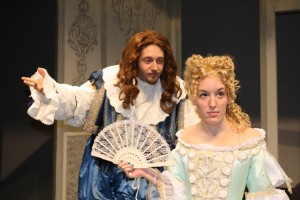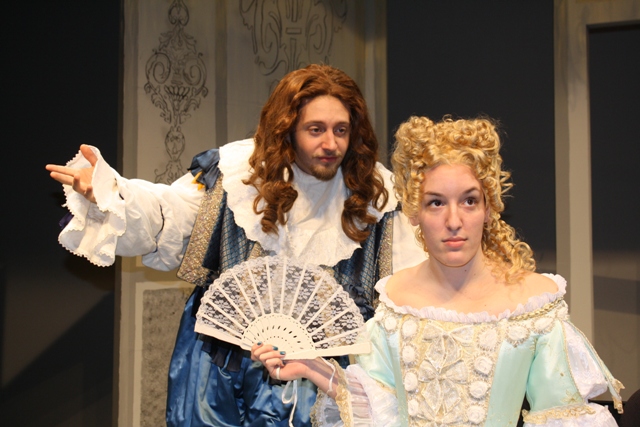Sometimes you can’t put your finger on what a show is missing until the end. In the case of West Chester University’s production of Moliere’s THE MISANTHROPE, I figured it out at the curtain call. The student cast came downstage for their bows, and, somewhat incongruously, the Kinks’ “All Day and All of the Night” started playing, and the cast started “rocking out” in full 17th century costume. It isn’t that the production needed more 60’s British Invasion music necessarily, but the moment did give the audience two important elements that it had only received intermittently throughout the evening. One, we got to see the cast loose, lively, and having fun, and two—well, we got to see the cast. There they were, down front, fully lit, and then it occurred to me—the whole play had been placed way upstage, on an admittedly gorgeous set, but almost invisible in audience terms. You could feel the lift in the audience during those few moments of curtain call hijinks—it was that clear. Make no mistake, the production is a worthy one—Moliere’s masterpiece is indeed presented, in the words of the program notes, “in its full 17th century glory.” It’s just that some of the gloriousness hasn’t quite made it to the stage yet.

Jima Vadala as Alceste and Kristie Perrotti as Celemene in West Chester University's production of THE MISANTHROPE - playing this weekend only! (Photo: Daniel Kontz)
Moliere’s prickly and challenging comedy, featuring one of his prickliest title characters, has a great deal to say about honesty versus tact, getting ahead versus being true to yourself, and that socially fatal point when maintaining your sense of integrity at all costs drives away love and friendship. “We’re all sharks,” Alceste, the misanthrope, proclaims, and he pointedly includes us in the audience in many of his most misanthropic pronouncements (which, again, would pack more punch if he were closer to us when he did so). We might recognize, as Moliere most likely wanted us to, that Alceste takes his mankind-bashing tendencies much too far. Nevertheless, Alceste’s railings against praising mediocrity and casual social lies make him more and more sympathetic in the 21st century—we might well agree, as the misanthrope is tormented by a series of twits as he tries unsuccessfully to navigate his legal and romantic woes, that if the world tended a bit more his way, as one character notes, it might not be such a bad thing.
If 17th century French nobility is a world of twits, however, they are twits with teeth, and it’s in the presentation of this world that the production comes alive. The ladies attack with a snap of their fans as well as with Moliere’s barbed rhyming couplets (translated in lively fashion by Rod McLucas), and the men are every bit as vicious beneath their flouncing foppery. The costume, wig and make-up design , by Igor Roussanoff and co-designer Erica Hoelscher, bring Moliere’s milieu to colorful life—we see how hard Moliere’s people must work to keep up their glittering appearances. The director, Leonard Kelly, puts his young cast through some stylized blocking, posing, and physical business, some of which draws laughter. It’s around the edges that the production provides the most pleasure, from a servant lighting a very high chandelier, to the portraits of the cast in the lobby, to the harp solos before the show and during intermission.
As for the performances, the young cast works hard and sometimes effectively, but they haven’t yet found a way to make Moliere’s archetypes (and his dialogue) their own. It’s a challenge for even the most experienced actors—once Alceste, for example, proclaims his disdain for mankind, he pretty much repeats it throughout the play. The rest of Moliere’s cast, partially drawn from the familiar types of commedia, similarly have one function and one note—vanity for one, common sense for another, and so on. There is every reason to believe, however, that the game young cast will improve and gel through the course of the run. In the meantime, consider West Chester University’s production a rare opportunity to see Moliere in 17th century costumes and setting—an opportunity that reveals a great deal about our own century as well.
THE MISANTHROPE
by Jean-Baptiste Poquelin Moliere
Directed by Leonard Kelly
March 23-27, 2011
WEST CHESTER UNIVERSITY
MADELEINE WING ADLER THEATRE
817 S. High Street,
West Chester, PA 19383
610-436-2533
TheatreDance@wcupa.edu



1 comment
Sir,
1) By necessity, this theatrical performance was held in a venue purpose built for musical performances.
2) In keeping with the Fire Codes, the set was constructed behind the fire curtain location.
3) “an admittedly gorgeous set, but almost invisible in audience terms”. That statement is a contradiction in terms. You were a member of the audience, witnessed the sets beauty, but claim it was nearly invisible.